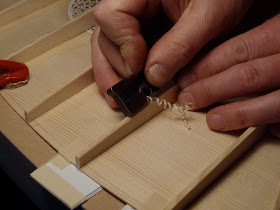Now things start to move along relatively quickly. If lute making was an action movie, the point we're at now would be at the beginning of a (really slow) car chase. In a reasonably short time, a number of pieces are going to be fitted together, and things will soon begin to look an awful lot like an actual lute.
The first thing to do after the main bars are on is to glue on a number of small bars that support the delicate pattern of the rose. Depending on the pattern, there might be a half-dozen or more placed strategically behind the rose:
Notice the ends of these little bars--I've scorched them with a hot iron. This is because of another amazing property of hide glue. While normally it takes a few minutes to set, and another few hours to dry hard, hide glue will crystallize instantly if it is scorched. So, rather than clamping each rose bar separately, all you need to do is brush some hot hide glue on the bar, stick it down in place, scorch the ends, and voila--the bar is stuck down securely, effectively clamped at each end, and the hide glue in the middle can dry naturally over the next few hours. I ask, is there anything hide glue can't do?
The larger bars have been glued on over-size, so the next job is to plane them down to their finished profile. Here are a pair of disembodied hands doing just this work:
The bars are chamfered along their tops, and their ends are given a long, gentle scallop. Here's what the 8 course belly looks like with this trimming done.
If you look closely at this photo, you'll see the outline of the lute's body that I craftily drew onto the belly just before gluing on the bars. At this point, I can trim back the ends of the bars until they are just inside that line, and begin the process of fitting the belly into the body of the lute.
I won't rely on just that line when I'm fitting up the belly to the body, however. In fact, I'll spend a lot of time at the bench trimming bar ends, fitting the body over the belly, looking at the outline of the lute and the curve of the outside rib, making sure I've got a smooth shape all the way around. This trimming and testing is the only way I have of making sure I'll have a good, smooth, aesthetically pleasing outline when the belly is eventually glued in.
Right now, though, I'm most concerned with getting a true and accurate fit because I want to find out where the bridge will be located (and glued) on the belly. Of course, I have a theoretical location in mind where I hope the bridge will go--it's on the detailed drawing I made of the lute long before I started to build it. Theory and reality don't always exactly match up, however, especially when putting together such a complex machine as a lute.
So what I do is carefully fit the belly into the body, and tape it securely in place.
Then I lay my detailed layout drawing on top of the lute, and see how theory and reality match up.
Hmmm... looks good. Looks very good, in fact. I flatter myself (and invite the wrath of the gods of lute making) by telling myself I must be getting good at this.
In fact, all three of the lutes in this batch look in very good shape. I'm able to mark the location of the bridges on their respective bellies by using only a couple of pricks of a sharp pin. Then, in a flurry of work and concentration, and following a carefully worked-out and time-tested routine, over three successive days I glue three bridges on three bellies.
If I've done my work correctly, I've created a glued joint on each that will withstand the combined tension of as many as a couple of dozen strings, and transmit the vibrations of those strings to the soundboard as efficiently as possible.
As with all of this, the proof will be in the playing... but for now, I'm very happy with the progress of these lutes.











